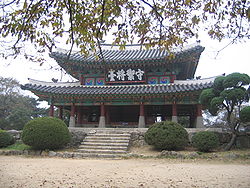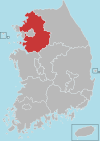world.wikisort.org - South_Korea
Gwangju[lower-alpha 1] (Korean pronunciation: [kwaŋ.dzu]) is a city in Gyeonggi Province, South Korea, a suburb southeast of Seoul. The city is not to be confused with the much larger Gwangju Metropolitan City, former capital of South Jeolla Province, South Korea.
Gwangju
광주시 | |
|---|---|
Municipal City | |
| Korean transcription(s) | |
| • Hangul | 광주시 |
| • Hanja | 廣州市[1] |
| • Revised Romanization | Gwangju-si |
| • McCune-Reischauer | Kwangju-si |
 | |
 Flag  Emblem of Gwangju | |
 Location in South Korea | |
| Country | |
| Region | Gyeonggi Province (Sudogwon) |
| Administrative divisions | 2 eup, 10 dong, 4 myeon |
| Area | |
| • Total | 430.99 km2 (166.41 sq mi) |
| Population (December 2013) | |
| • Total | 286,699 |
| • Density | 665.2/km2 (1,723/sq mi) |
| • Dialect | Seoul |
History
Bunwon-ri in Gwangju took an important role of ceramic production during the Kingdom of Joseon. There had official kilns and produced superb quality of white porcelains for use at the royal court and to export to China.[3]
In 1962, 4 myeons (townships) including 5 ris (villages) were incorporated to Seoul.[4]
In 1973, 6 ris were separated and became a part of Seongnam city. In 1979, Gwangju-myeon was elevated to an eup. Gwangju county became a city in 2001.[5]
Festival
Gwangju Toechon Tomato Festival - Gwangju City, Gyeonggi Province has been holding a festival since 2003 to promote the city's pollution-free tomatoes and sell them to consumers.
Notable people
- Ahn Sun-ju (1987), professional golfer
- Kim Yu-bin (1988), singer and actress
- Choi Soo-young (1990), singer and actress, member of Girls' Generation.
- Lee Hong-gi (1990), singer and actor
- Lee Hye-ri (1994), singer and actress
- Julio Ko (1970), kayaker and educator
- Yoon Shi-yoon (1986), actor and variety entertainer
- Hyungwon (1994), member of boy group Monsta X
- Lee Ju-yeon (1998), member of boy group The Boyz
International relations
This section does not cite any sources. (July 2018) |
Sister cities
Friendship cities
 Faku County, Liaoning, China
Faku County, Liaoning, China Dornogovi Province, Mongolia
Dornogovi Province, Mongolia Bathurst, New South Wales, Australia
Bathurst, New South Wales, Australia
See also
- Joseon white porcelain
- Korean pottery and porcelain
- List of cities in South Korea
- Geography of South Korea
Notes
- In the 19th century, Gwangju was sometimes spelled Koang-tsiou.[2]
References
Citations
- 광주역사-연혁. Archived from the original on 2014-07-18.
- EB (1878), p. 390.
- John Onians (2004). Atlas of World Art. Laurence King Publishing. p. 205p. ISBN 978-1-85669-377-6.
Government-sponsored kilns at punwon-ri, near Seoul, produced an exquisite and distinctive Joseon white porcelain for use at court and for export to China. Its undecorated cream-colored surfaces, and austere elegant shapes were thought to reflect a purity of mind and moral character appropriate for Neo-Confucian patrons.
- Law concerning Seoul metropolitan city, provinces, counties, districts and counties(1962. 11. 21.)
- Establishment of new cities including Hwasung.(2000. 12. 20.)
Bibliography
- , Encyclopædia Britannica, 9th ed., Vol. VI, New York: Charles Scribner's Sons, 1878, pp. 390–394.
External links
- City government website (in English)
- City Council website (in Korean)
На других языках
- [en] Gwangju, Gyeonggi
[ru] Кванджу (Кёнгидо)
Кванджу́ (кор. 광주시?, 廣州市?) — город в провинции Кёнгидо, Южная Корея. Название города, записанное на ханча, идентично китайскому городу Гуанчжоу.Другой контент может иметь иную лицензию. Перед использованием материалов сайта WikiSort.org внимательно изучите правила лицензирования конкретных элементов наполнения сайта.
WikiSort.org - проект по пересортировке и дополнению контента Википедии
